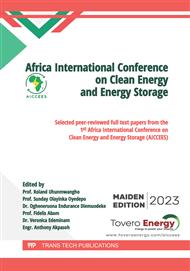p.67
p.81
p.91
p.115
p.129
p.149
p.159
p.171
p.181
The Design and Energy Simulation of CO2 Capture Process (CCP) for a Liquefied Natural Gas (LNG) Plant
Abstract:
The design and energy simulation of carbon dioxide captured process through which Liquefied Natural Gas (LNG) plant has been achieved using Monoethanolamine (MEA) as a solvent. An optimization and technical parameter study for which CO2 captured process (CCP) from the flue gas of a natural gas liquefaction plant was formed based on absorption/desorption process with MEA solutions, using ASPEN HYSYS. This optimization was aimed at reducing the energy requirement for solvent regeneration, by investigating the effects of CO2 removal percentage, stripper operating pressure and cooling water flow. Also, the study showed that major energy savings can be realized by optimizing the lean solvent loading the CO2 transmission phase as well as the stripper operating pressure through the compression and pumping process in the CCP. The specifications, equipment thickness, and cost models were developed based on the principles of conservation of mass and energy, and thermodynamic principles. Aspen HYSYS simulation was carried out on the entire CCP using flue gas of composition carbon dioxide (8.7%), water (17.8%), nitrogen (73.3%), oxygen (0.2%), sulphur dioxide (0.0017%), and nitrox (0.0097%) with input process conditions of pressure 101.6kPa, temperature 150°C and flow rate of 500tons per day. During the study, a minimum thermal energy requirement was found at a lean MEA loading of 0.13, using a 40 wt.% MEA solution and a stripper operating pressure of 130 kPa, resulting in a thermal energy requirement of 1.025 GJ/ton CO2. Recoveries were done at 75%, 80%, 85%, 90%, 95% and 99% of the simulation process. Suitable correlation models were developed relating to the energy consumption rate per stripper operating pressure and specific thermal energy consumption per solvent flow rate with percentage recoveries. When compared to the simulation result, minimum errors of 0.05% and 2% respectively were obtained. The relationship between the compressor power and CO2 recovery was linear at a minimum power consumption of 130 kW at 75% recovery while a maximum consumption of 175 kW was obtained at 99% recovery. It was observed that the specific thermal energy consumption per solvent is linearly related to the extent of recoveries, as higher energy was required to recover more CO2. Compression and pumping with supercritical liquefaction taking the CO2 above critical pressure of 100bar through three compression sections, inter-cooled to 40°C with water at ambient conditions. Thus, enhancing the high efficiency of the system. The HYSYS simulation results, the process conditions and the characterized flue gas were used for the manual computations to determine the efficiency of the CO2, the size and specifications of the absorber and the amine regenerator columns. The HYSYS results obtained from the simulation of the entire CCP gave a recovery of 99% of the CO2 removed from its initial content (8.7%). The energy and thermodynamic analysis of the CCP carried out gave result with the cycle efficiency of 94.92%, an efficient process with 20% energy reduction due to compression and pumping action done by incorporating pumps in the process. The results of the specifications from the material balance of the absorber and amine regenerator columns gave the diameter, height, and number of trays of these units in the CCP as, 2.215m; 10m, and 25, and 2m; 6m, and 20 respectively. While, the thickness results for the ellipsoidal doomed head and cylindrical shell of the absorber and amine regenerator columns were respectively given as, 8.27mm and 8.26mm, and 81.17mm and 78.33mm. The overall cost, including the cost of utilities, for the entire plant was obtained to be $19.629m.
Info:
Periodical:
Pages:
181-192
Citation:
Online since:
March 2024
Authors:
Keywords:
Price:
Сopyright:
© 2024 Trans Tech Publications Ltd. All Rights Reserved
Share:
Citation:


